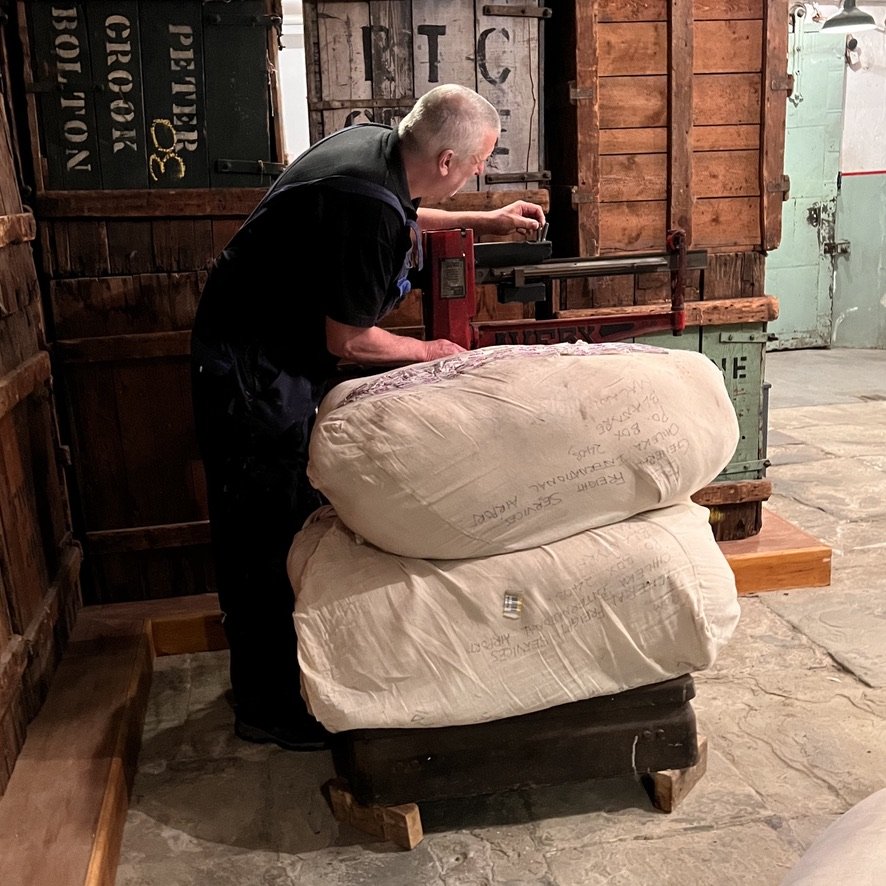RETURN TO RECENT WORKS
PROJECTION CLOTH, 2023
Details:
Installation of four films projected onto a Fustian cloth in the Cruck Barn, Pendle Heritage Centre, Installation Dimensions Variable
Films:
THE FLAX GROWER
2021
Motion-captured 3D visualization
12 minutes, looped
Narration by Christine Borland & Grace Borland Sinclair
CGI by John Butler
THE FLAX SPINNER
2021
Motion-captured 3D visualization
12 minutes, looped
Narration by Christine Borland & Grace Borland Sinclair
CGI by John Butler
THE COTTON GROWER
The Sower’s Daughter, Dig
2021
Motion-captured 3D visualization
12 minutes, looped
Narration by Christine Borland & Grace Borland Sinclair
CGI by John Butler
THE COTTON SPINNER
The Sower’s Daughter, Dig
2021
Motion-captured 3D visualization
12 minutes, looped
Narration by Christine Borland & Grace Borland Sinclair
CGI by John Butler
Photography:
Christine Borland & Jack Bolton, BTB
Links:
British Textile Biennial Programme
Contemporary Art Society
Corrridor8
Selvedge
Downloads:
Text commissioned by Creative Lancashire, Dr Caroline Stevenson
DESCRIPTION
In Borland’s installation for the British Textile Biennial 2023, four films were cast onto a Projection Cloth of a material called fustian, which is a mix of linen warp and cotton weft, historically associated with Lancashire. The cloth was hand-woven on site by the artist and master-weaver Lynne Hocking on a loom built into the structure of a medieval cruck barn at Pendle Heritage Centre in East Lancashire. Developed through the artist’s direct engagement with the growing, spinning and weaving of plant fibres, the films documented the physical movements inherent in the processes. A story of womens’ lives emerges from the digital figure’s abstracted motions, accompanied by the soundtrack of a dialogue between the artist and her daughter Grace Borland Sinclair, which quotes from mythology, folklore, religion, philosophy and natural history.
From growing and hand-working, through industrialisation, to our digital age and into a speculative future, the work touches on plant and textile lore and the symbolism associated with it in the demonised image of women as witches. This resonates deeply in Pendle, where Projection Cloth was created, as ten women and one man, some of them intimately linked to textile practices, were among the last people to be hanged in England for witchcraft in 1612.
Click the links to access narrative dialogues written by the artist and her daughter Grace Borland Sinclair, which accompany the Projection Cloth films; THE FLAX GROWER, THE FLAX SPINNER, THE COTTON GROWER, THE COTTON SPINNER.
To hear more about this work, listen to Borland’s conversation with artist Eva Sajovic and Amber Butchart in Season 3 Episode 7 of the Cloth Cultures podcast.
Thanks to The Department of Museums and Monuments, Malawi, Dr. Lovemore Mazibuko, Hezileki Perekamoyo and Comfort Tamanda Mtotha, Deveron Projects, Timespan, #Lineation flax growers, weaver Lynne Hocking, Eilidh Guthrie, Helmshore Mills Textile Museum, The Bowland Guild of Weavers and Dyers and Spinners, John Butler, Ross Sinclair and Andy McGregor. For clay work, thanks to Lee Cartledge, Bentham Pottery, Lancashire, Andrew Appleby, Fursbeck Pottery, Orkney, Eilidh Guthrie and Agnes Borland Sinclair Argyll, Scotland.
This project was co-commissioned with The Super Slow Way.
research/process
The project developed through considering fustian cloth as a manifestation of the transitional historical time-period (roughly between the 15th and 17th centuries) which brought great change in relation to the status, power and identity of women and saw the widespread persecution of witchcraft in Early Modern Europe and the trials of the Pendle witches in 1612. Much research around fustian/s is contradictory but several sources state;
The first use of cotton in Lancashire was in the production of fustians, as a cloth with linen warp and cotton weft, that evidently began in the second half of the 16th century, possibly as early as the 1560’s.
Through the manufacture of a piece of cloth using preindustrial and industrial means and materials which come from diverse, unconventional sources, the focus of the project extends through women criminalized as witches both at the dawn of capitalism and in contemporary globalization.
The flax used in the Projection Cloth’s warp was grown by participants from all over the country in the lock-down project #Lineation and spun in Lancashire by The Bowland Guild of Weavers, Spinners and Dyers. The cotton used in the cloth’s weft, was grown and ginned (the process of removing the seeds) in Ngabu, Southern Malawi; it was imported to Scotland as part of an exhibition at Timespan, Helmsdale in 2017, before being brought to be processed at Helmshore Mills, Lancashire then spun by hand by the artist using a Charkha - a hand operated spinning machine invented in India. The clay loom weights forming part of the loom are made from wild clay, dug from relevant sites in Lancashire and Scotland. All wooden loom parts were sourced and prepared locally by designer and maker Phillipe Handford.








































